
|   |

|   |
 e-mail: ukb7@rediffmail.com Classicism alongside regional flavors March 25, 2020 Looking across the board at the performing art treatises ascribed to the late first and early second millennia - such as Abhinaya Darpana by Nandikeswara, Dasarupaka by Dhananjaya, Manasollasa by Someswara, Brihaddesi by Matanga, Nrittaratnavali by Jayasenapati, in that order, among others -- some scholars believed that the Desi (regional) tradition differs from the Marga (classical) in two major ways. One, by putting its emphasis on the style of presentation rather on the context of the composition, and second, by concentrating on the use of more demonstrative, even acrobatic movements. This deems that Marga aspires to be spiritual, transformational or metaphysical experience, whereas Desi is aimed at entertaining. Single codification of dances has tapered down due to ruling kings and temples that dictated what was pure and could be sanctified. But 'regional' is not an antonym to the words 'pure' or 'path'. Desi signifies all aspects of art that are not intentionally created but are rather products of human evolution. It is mostly a naturally-evolved practice, both ritualistic and entertaining in nature. Adhering to this definition, Marga is a consciously created and learnt art. It is only in the later parts of 20th century that their connotations took another turn as 'folk' and 'classical'. Sangeet Natak Akademi gave credentials to eight forms as classical, the rest being folk. (Koodiyattam the Sanskrit theatre as old as Sangam era is officially recognized by UNESCO as "Masterpiece of the Oral and Intangible Heritage of Humanity", but does not figure in the SNA list. Again, many scholars believe that Siddendra Yogi was influenced by Yakshagana to create Kuchipudi, but the former is yet to receive a classical status. On the whole, Marga or classical seems less to do with rigidity and in that sense tradition, and more to do with acceptance, assimilation and change. They had to be edited to fit within the accepted norms of devotional, elitist and courtly tastes. Both forms are not always contemporary creations but products of continuous cross-cultural interactions from centuries before and are, in many ways, always evolving. 'Marga' and 'Desi' do share intertwining dynamics, whose definition and presentation are ever changing in the history of Indian performing arts. It was fascinating to observe such interactions in recent presentations of four classical forms. Nava Pallava 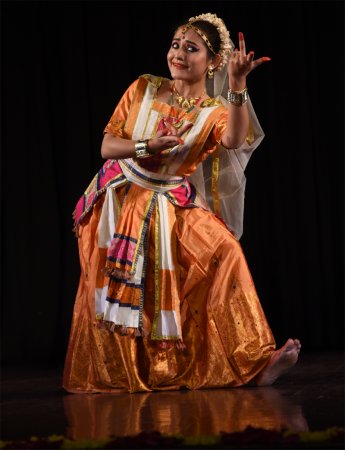 Meenakshi Medhi Presented on March 8 under the joint initiative of Sharmila Biswas, Darshan Shah and Alka Jalan - to promote young meritorious artists with "crowd funding" to find their feet rather than "pay and perform" - Meenakshi Medhi took the stage first with Sattriya dance, recognized by SNA as 'classical' hardly two decades ago and yet to find votaries from outside Assam. Trained under the Late Prof. Jibanjit Dutta and now under Prof. Haricharan Bhuyan Borbayan, Meenakshi began her recital with Ramdani (invocation) of Hajowalia Saali Naas, a pure dance ascribed to Saint Madhavadeva and performed to rhythmic sound syllables of khol in Suta tala and Thukoni tala. This was followed by slokabhinaya, Sarata Sasanka Kara..... from Keli Gopal Nat composed by Saint Sankaradeva. Simple in content, almost entirely front-facing and very devotional in execution, the dance bore the stamp of its monastic, masculine genesis in the Sattras (monasteries) all over. She concluded her recital with an abhinaya based item on Putana Vadh and Bakasura Vadh, the well-known stories of the child Krishna from Bhagavad Purana. Relatively free to show her penchant in angikabhinaya in depicting the prowess of the little cowherd god - while dealing with the demon Putana in the garb of a Gopi and the fierce demon Baka attacking him as a huge bird - Meenakshi did quite well. As a whole, it did appear that Sattriya should evolve some more to become "a many splendored" dance at all-India level. Also considering that the scope of the dance was limited only to Gopis (since the saintly-duo did not usually worship Radha), a conclave of the present Sattriya gurus would seem to be necessary to enhance its repertoire and abhinaya in as many ways as possible. They should especially imbibe the rich regional traditions of Assam, on the model of the erstwhile Odissi gurus at the end of the fifties, whose 'Jayantika' conclave did wonders to take Odissi far beyond its Mahari and Gotipua legacy. 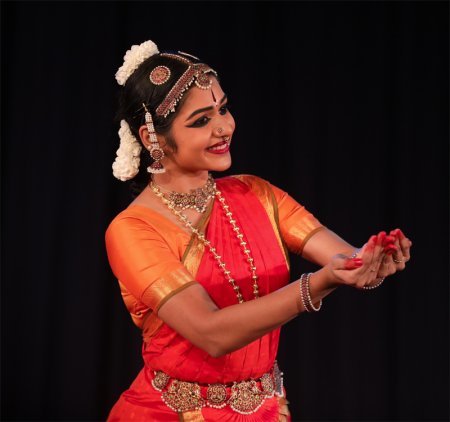 Shruthipriya Ravi It was sheer joy to witness Shruthipriya Ravi coming next to perform Bharatanatyam. Beginning very early under J. Suryanarayana Murthy, then under Nithyakalyani Vaidyanathan and now being groomed under Bragha Bessell, Shruthipriya has come a long way in all 21 years of her performance. Launching an innovative composite item, Ananda Koothadum, she chose five kinds of Yati from Natya Shastra, namely Sama Yati - same; Mridanga Yati - small to big to small; Damaru Yati - big to small to big; Gopuchcha Yati (cow's tail) - big to small; and Strothovaha Yati - small to big. She explained at the outset, how the teermanams (the ending adavus) would follow patterns like Kitathakatharikitathom, Kitathakatharikitathom, Kitathakatharikitathom in Sama Yati, while it would be Kitathaka tharikitathom, Tha kitathaka tharikitathom, Kitathaka tharikitathom for Mridanga Yati. In a delightful exposition of ekaharya abhinaya, she executed her Yatis both as Nataraja enjoying his celestial dance and his devotee ecstatically observing Shiva perform the moves. She used engaging anecdotes to illustrate the five Yatis in that order, such as, Shiva treating the gods and demons - equally - by drinking the Alaahala poison during the churning of the Mandara mountain; Shiva playing mridanga; the demons engaged in the battle being mortally scared, then recovering partially and finally totally devastated, like the varying size of damaru; Nandi playing mridanga with his tail wagging to and fro; and Shiva adorning his matted hair with the crescent moon on one side and the Ganga's majestic grace on the other. The spectators were enchanted. Just to set the records straight, one may note that Bharatanatyam is probably the most developed among all the classical dances and most widespread, thanks, among other factors, to its fully integrating the Kuruvanji folk plays, pioneering efforts put in by Rukmini Devi and the loving care bestowed by generations of Meenakshi Sundaram Pillai's family and other diligent gurus. Both dancers used recorded music. Ritachhanda Festival 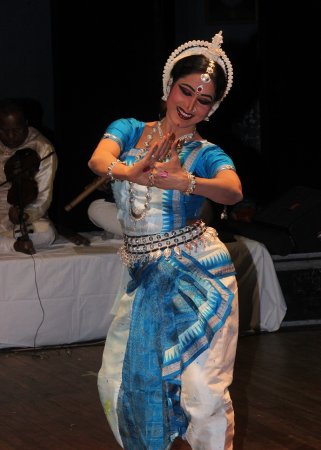 Sujata Mohapatra Presented on March 13 by SNB Foundation, the petite Sujata Mohapatra took the stage first with Odissi dance. Hers was a picture-perfect performance with a svelte figure matching the Greek "golden proportions", an enchanting smile and a total command over her angikabhinaya. She began her Mangalacharan with a Shanta Karana in Gurjari Todi raga and Jyoti tala wonderfully executed raising high expectations, amply met in her more elaborate Hamsadhwani Pallavi. A handiwork by guru Kelucharan Mohapatra and music by Pt. Bhubaneswar Misra in ekatali, right from the refrain Taka jhinu tajhum tajhum tarijhum, she was in her elements in letting her nritta blossom into a splendorous visual experience. It must be remembered that Kelubabu had taught his gifted daughter-in-law the best of sculpturesque postures by going round the region to Lingaraj temple, the Jagannath temple, and the Sun temple, among countless other sites and drawing sketches of the divine dancers with his unerring painter's eye inherited from his Raghurajpur childhood. This legacy was more than evident when in the jugalbandi sequence with the mridang, she could always end on a sculpted stance that was sheer frozen poetry! Switching over to the abhinaya item Ahe neela shaila... this was the only choreography of Kelubabu to the non-Hindu poet Salabeg's devotional music in tala Jyoti. Salabeg - a Muslim devotee of the lord - was despised by the people of the region, although his songs are de rigeur in Puri's majestic Rathayatra, as heard by this critic. How the poet described Krishna's compassion for the downtrodden - in the three episodes of the Gaja-Makara encounter, Draupadi's ignominy in the Kaurava court, and Prahlada's salvation from his demon father by the Narasimha incarnation of Vishnu - was a treat to see. She concluded with an Ardhanareeswara Stotra by Adi Shankara in ragamalika and talamalika exquisitely demarcated between Parvati's lasya with her tender gestures, delicate movements, attire and adornments, and Shiva's tandava with virile postures, leaps and jumps, bare-bodied grace and snakes worn as jewellery, a grand finale. Her very competent musical accompaniment was provided by Rajesh Kumar Lenka on vocal, Ekalavya Muduli on mardala, Soumya Ranjan Joshi on flute and Ramesh Chandra Das on violin. Lighting by Dinesh Poddar was particularly effective. 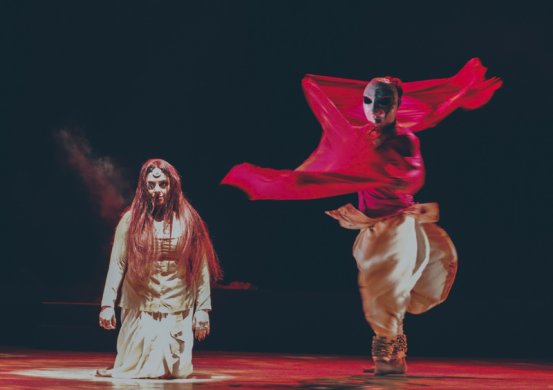 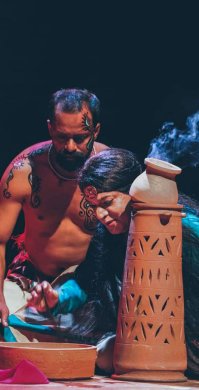 Shikhandini Shikhandini, the dance drama based on the intriguing Mahabharata episode on transgender voyeurism, was presented by Upasana Centre for Dance as an elaborate theatrical spectacle. The well-known story revolves around the Kashi princess Amba, who had selected Shamba as her husband in the Swayamvara, is abducted by Bhishma for his own brother Vichitravirya's nuptial. On her insistence, she is released on the way, but now the spineless Shamba too, rejects her. Bounced back to Bhishma as a bad coin, she is declined by the Kuru stalwart, betrothed to lifelong bachelorhood. Amba vows on her revenge on Bhishma, immolates herself in fire and is reborn as a woman again. Raised as a boy, she claims the male gender from Yaksha, joins Arjuna in the great battle of Kurukshetra and pelts arrows at Bhishma who refuses to fight a woman. Having served her purpose of revenge, she is heard no more in the epic! Directed adroitly by Ashim Bandhu Bhattacharya, the panoramic light-and-sound show is enacted beautifully, while Dinesh Poddar's "effect lighting" creates hypnotic scenes equally matched by imaginative blocking of the dancer-actors using vigorous Kathak along with impressive histrionic feats. Yaksha is particularly effective with his Kalaripayattu grooming. That human beings are mere puppets in the hands of an invisible destiny is the backbone of the entire episode, using a human observer - masquerading in mask as a puppet - threading through all the events. Using the tale of hapless Amba pulled at once in different directions, turned into Shikhandini with her own narrative of gender exploitation, the dance-drama was a very imaginative production broadening the horizons of classical Kathak. Kudos to Ashimbandhu for pulling off a top quality work! Tanni Chaudhuri as Amba, Mayukh Duta as Bhishma, Kajol Hazra as Yaksha and Avik Chaki as puppet rounded off by Ashim Bandhu himself as the eponymous Shikhandini, acquitted themselves well.  Dr. Utpal K Banerjee is a scholar-commentator on performing arts over last four decades. He has authored 23 books on Indian art and culture, and 10 on Tagore studies. He served IGNCA as National Project Director, was a Tagore Research Scholar and is recipient of Padma Shri. Post your comments Please provide your name and email id when you use the Anonymous profile in the blog to post a comment. All appropriate comments posted with name and email id in the blog will also be featured in the site. |